Understanding the Price of Five Carat Diamonds
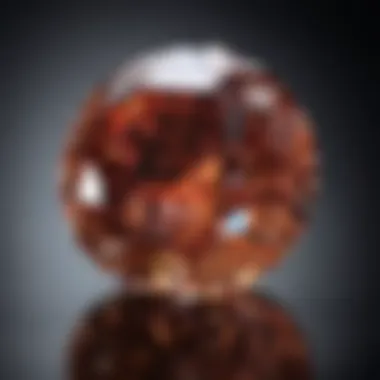
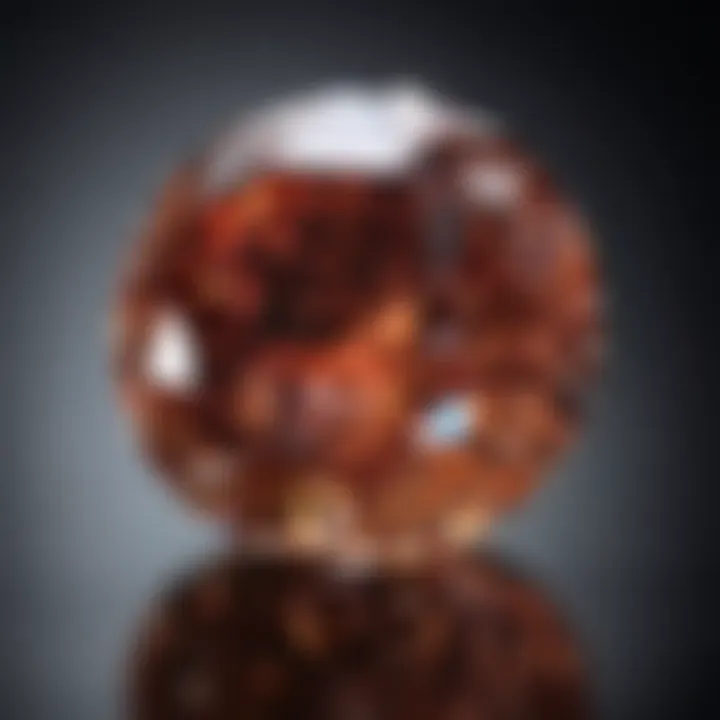
Intro
When it comes to gemstones, few can compare to the allure of diamonds, particularly those that weigh in at five carats or more. Not only is a five-carat diamond a remarkable sight, but it's also a significant investment. In this journey to understanding its value, we will dissect key factors that contribute to its price and appeal. From the four Cs that form the backbone of diamond grading to the nuances of market dynamics, this piece aims to provide a thorough examination for both enthusiasts and buyers alike.
Gemstone Overview
Definition of Gemstones
Gemstones are naturally occurring minerals that are either cut and polished for use in jewelry or serve various industrial purposes. Gemstones are cherished for their beauty, rarity, and durability. They can be categorized into precious and semi-precious stones, with diamonds commonly classified as the former due to their unmatched hardness and brilliance.
Classification of Gemstones
In the gemstone world, classification can vary based on several factors:
- Mineralogical Properties: This includes the chemical composition and crystal structure.
- Value and Rarity: Generally, precious stones like diamonds, rubies, emeralds, and sapphires hold higher value due to their scarcity.
- Use in Jewelry: Some stones are favored for ornamental purposes, while others may be used for investment reasons.
Gemstones carry different meanings throughout various cultures, and their classification often incorporates this significance.
Historical Significance
Origins of Gemstone Use
From ancient times, gemstones have captured human fascination. The use of gemstones dates back thousands of years, where they were often worn as talismans or status symbols. Diamonds, in particular, were first discovered in India, and by the 13th century, they had made their way to Europe, becoming the ultimate symbol of affluence and strength.
Cultural Insights: Gemstones in Ancient Civilizations
Gemstones weren’t just for adornment; they were steeped in beliefs and traditions. For instance:
- Ancient Egyptians linked lapis lazuli to the divine, often burying the stone with their pharaohs.
- Greeks associated sapphires with Apollo, believing they bestowed wisdom and protection.
- Romans valued emeralds for their association with Venus, the goddess of love.
This historical lens enhances our understanding of the desirability and significance of diamonds today. Diamonds have evolved from symbols of power to tokens of love and commitment.
In understanding the value of a five-carat diamond, it becomes crucial to appreciate these layers of historical and cultural insights.
In the forthcoming sections, we will delve deeper into the core components influencing a five-carat diamond’s valuation, unraveling the intricacies of the four Cs and how they interrelate with market trends.
Foreword to Five Carat Diamonds
When it comes to diamonds, few stones command the attention quite like a five carat one. Many enthusiasts and collectors view this weight as the golden ticket, embodying both luxury and status. This section of the article dives into why five carat diamonds stand apart in the extensive hierarchy of gemstones, and why they are significant to the market.
Definition of Carat Weight
In the gemstone world, the term "carat" refers to the weight of the diamond. One carat is equivalent to 200 milligrams. Yet, the significance of a carat goes well beyond mere weight; it relates to how light interacts with the diamond. Each carat adds weight, but also affects the stone's visual presence. A five carat diamond isn’t just heavier; it can also be more visually striking, often resulting in a bolder look that catches the eye. This weight can amplify the diamond's brilliance and sparkles, creating a captivating display that lesser stones simply can’t match.
Significance of Five Carats
So, what’s the big deal about hitting the five carat mark? Beyond its physical dimensions, this size is often viewed as a symbol of affluence and achievement. Purchasing a five carat diamond is not a mundane buy; it’s a milestone often associated with meaningful occasions such as engagements, anniversaries, or significant personal achievements. It’s an indication of commitment, both in terms of love and financial investment.
From an investment standpoint, diamonds of this weight can also represent considerable value. In a world filled with interchangeable luxury items, five carat diamonds tend to hold their worth exceptionally well. Collectors often seek them out due to their rarity, with larger diamonds being increasingly hard to find as time goes by.
"Investing in a five carat diamond is like placing a bet on both beauty and market endurance."
Additionally, the societal perception leans heavily in favor of larger stones making a statement. When one dons a five carat diamond, it often tells a story of luxury and taste that goes beyond simple aesthetics. It signifies the wearer’s appreciation for fine craftsmanship and the unique allure that a rare gem possesses.
In summary, understanding the value of five carat diamonds not simply encompasses an understanding of weight. It delves into the emotional narratives and the market trends surrounding such exquisite pieces. This discussion sets the stage for exploring detailed elements such as the four Cs, market influences, and how these diamonds fit into the broader investment landscape.
Understanding the Four Cs
When it comes to five-carat diamonds, grasping the concept of the Four Cs is crucial. These Four Cs—carat, cut, clarity, and color—serve as the bedrock for evaluating a diamond’s value and quality. Each of these elements carries its own significance and together they form an integral framework that guides buyers through the often intricate process of choosing the right stone. For gemstone enthusiasts and collectors, understanding the Four Cs is akin to having a compass in uncharted territory; it helps navigate the precious diamond market by making informed decisions.
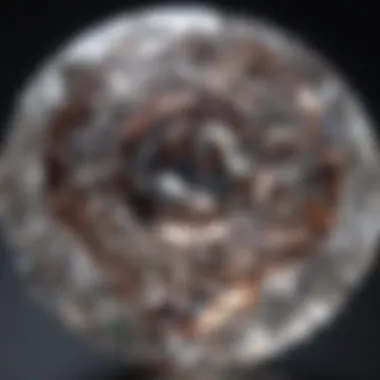
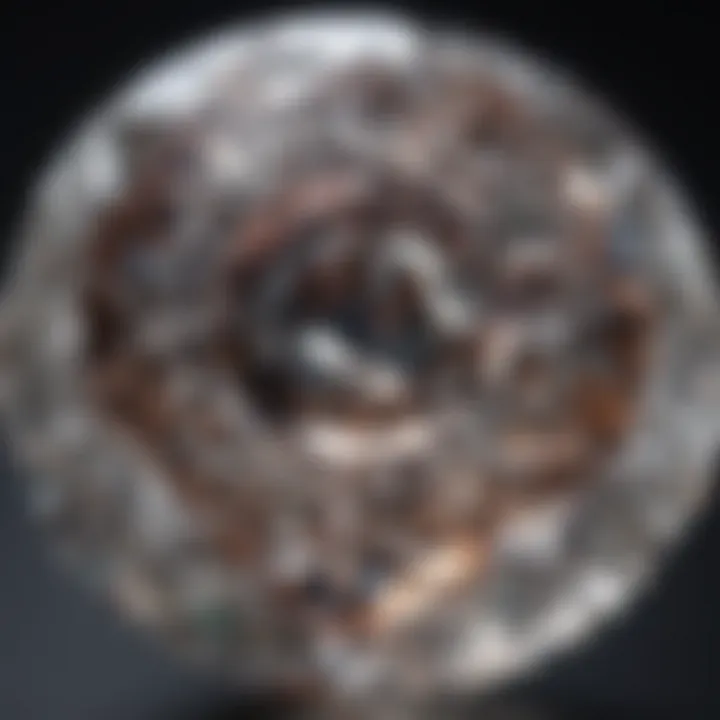
Carat: Weight vs. Size
Carat weight isn’t just about heft; it’s also about how the diamond appears to the eye. A five-carat diamond might sound significantly larger than a smaller stone, but the visual difference can depend on other factors, mainly the cut.
- Carat refers to the weight of the diamond rather than its size. 1 carat equals 200 milligrams. Therefore, a five-carat diamond weighs a hefty 1,000 milligrams.
- Size perception can vary based on the diamond's dimensions. A diamond with a superb cut can look larger than a poorly cut one of the same weight.
So, when buyers consider a diamond, it’s essential to remember that they should not only look at the carat weight, but also at how that weight translates visually. A five-carat diamond may dazzle more due to its exceptional proportions than another diamond of the same weight that lacks the right cut.
Cut: The Art of Faceting
The cut of a diamond represents one of the most important attributes that influence its overall appearance and brilliance. A well-cut diamond reflects light in a manner that captivates the beholder. Experts often say that the cut can make or break a diamond.
- Symmetry and Proportions: The angles and facets of the stone are what truly allow light to dance within it. For five-carat diamonds, professional-grade cuts are essential since the weight provides ample opportunity for creating a symphony of sparkle.
- Grading Systems: Cuts can be graded from Excellent to Poor, with the best cuts maximizing light reflection and providing stunning brilliance.
Finding a five-carat diamond with an optimal cut can be like striking gold, as that is where beauty and value converge.
Clarity: Assessing Internal Flaws
Clarity refers to the presence of internal or external imperfections, commonly known as inclusions and blemishes. For potential buyers of five-carat diamonds, clarity is a vital consideration, since these stones often come under close scrutiny.
- Clarity Grading: Clarity is typically categorized into various grades, from Flawless (no inclusions visible under 10x magnification) to Included (inclusions noticeable to the naked eye).
- Impact on Value: Higher clarity generally means higher value. A five-carat diamond that’s Flawless can be remarkably rare and hence more expensive than one that is included.
When spending significant money on a five-carat diamond, knowing its clarity status allows buyers to feel secure in their investment. It’s like buying a car; you wouldn’t want a vehicle with hidden issues, now would you?
Color: The Spectrum of Diamonds
The color of a diamond plays a crucial role in its appeal and value. Diamonds are graded on a scale from D (colorless) to Z (light yellow or brown), with colorless diamonds being the most sought after.
- Finding the Right Hue: A five-carat diamond with no tint at all elevates its worth significantly. In fact, compared to a subtle yellow-toned diamond, the clear, colorless option will usually attract a better price and more admiration.
- Fancy Colors: It's worth mentioning that some diamonds come in vivid hues such as blue, pink, or green. These fancy-colored diamonds can turn the market on its head regarding value, often appearing on auctions at mind-boggling prices.
Ultimately, understanding the color grade of a five-carat diamond not only informs buyers about its visual appeal but also its potential investment value.
"A diamond is forever, but understanding its value can lead to a truly timeless investment."
In summary, the Four Cs not only determine the essential characteristics of a diamond but also serve as guiding principles for making informed purchasing decisions. For buyers of five-carat diamonds, knowing the ins and outs of carat, cut, clarity, and color provides a solid foundation for understanding their options in a complex and intriguing marketplace.
Market Influences on Diamond Pricing
Understanding the market influences on diamond pricing is key for anyone considering purchasing a five-carat diamond. In the diamond trade, value fluctuates based on several interconnected factors. Recognizing these elements can empower buyers, allowing them to make informed decisions that align with their desires and financial capabilities.
Diamond Rarity and Availability
The concept of rarity is central to the perceived value of diamonds. Five carat diamonds aren’t prevalent. In fact, as the carat weight increases, availability decreases significantly, making larger stones more sought after. Many buyers chase after these extraordinary stones, often believing that owning one is synonymous with status and wealth. This scarcity drives prices up.
Additionally, the sourcing process plays a part here. The origin of the diamond matters. Certain areas boast higher-quality stones, which can affect price points. If a five carat diamond is sourced from a notable locality, it could fetch a higher price than a similar one from a less renowned area, regardless of its physical characteristics.
Market Trends and Demand
The demand for five carat diamonds follows social and economic trends. Currently, there's a notable swing toward larger gemstones, and, as a result, prices tend to trend upward. Those with disposable income seek the charm of bold, impressive jewelry. Marketing strategies often reflect this growing desire, frequently emphasizing dramatic designs and larger stones.
Cultural influences can’t be ignored either. In some cultures, there's a tradition of gifting larger diamonds for significant life events. When these cultural moments arise, demand can spike, leading to higher prices in the market temporarily. It creates a cycle of rarity that potential buyers must consider.
"The allure of a five carat diamond isn’t just about size; it's also about the story behind every piece and its cultural significance."
Economic Factors Affecting Prices
Finally, various economic factors shape diamond pricing dynamics. From the fluctuations in the global economy to the influence of individual currencies, these elements play a significant role. When the economy is strong, the luxury market tends to thrive, and consequently, diamond prices can soar. Conversely, during economic downturns, people tighten their wallets, leading to reduced demand, and prices can experience a slump.
Supply chain issues, geopolitical events, and changes in mining regulations also produce ripples in the diamond market. For example, if new mines are discovered or production increases, prices could stabilize or even drop. Alternately, if political unrest in a key diamond-producing country occurs, prices may spike due to uncertainty.
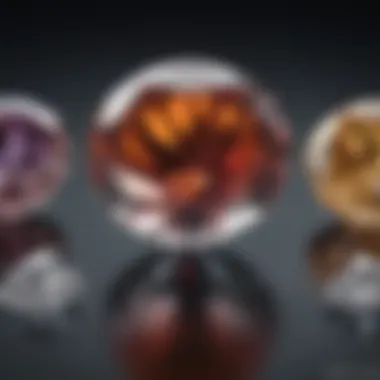
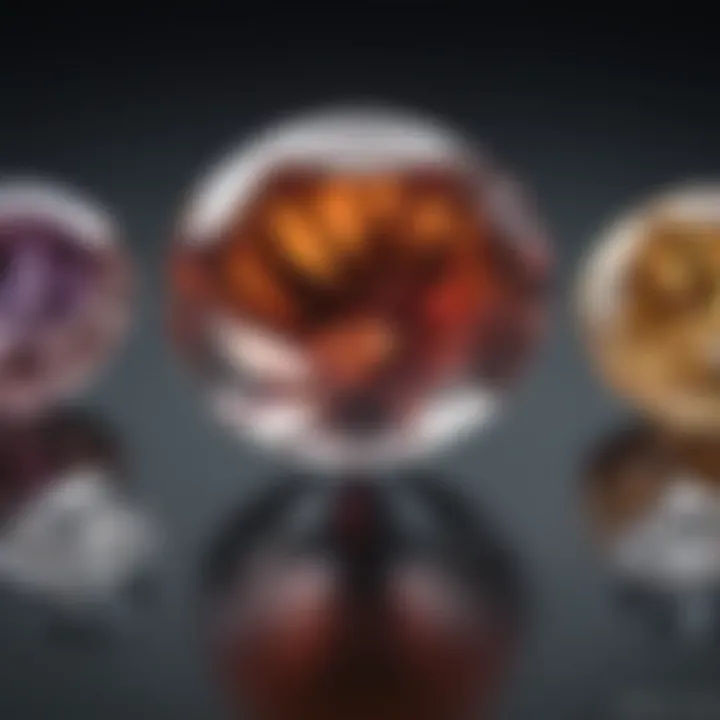
Comparative Pricing of Five Carat Diamonds
When it comes to understanding the value of a five-carat diamond, grasping the comparative pricing is essential. This aspect not only affects potential buyers but also gives insight into market trends, the rarity of certain sizes, and the intricacies of the diamond itself. Evaluating how five-carat diamonds measure up against other sizes can guide buyers in making informed decisions, particularly if they’re seeking a unique piece or making an investment.
Comparison of Five Carat vs. Other Sizes
Five carat diamonds stand out in a crowded market, but how do they stack up against their smaller counterparts? In general, carat weight plays a significant role in determining a diamond's price; however, the relationship isn’t always linear. Here's a closer look:
- Perceived Value: A five-carat diamond is often regarded as a status symbol. A two-carat or three-carat diamond might be stunning, but a five carat takes it to a new level of opulence.
- Cost-Effectiveness: Interestingly, larger diamonds do not simply multiply in price by their carat weight. For instance, while a three-carat diamond might cost significantly less than a five-carat one, the price per carat can dramatically increase as the carat weight rises. In practical terms, the jump from four to five carats can lead to a higher price per carat.
- Market Limitations: Availability plays a crucial role as well. Larger diamonds are less common, so finding a high-quality five carat can require more time and greater investment.
It’s often suggested that buyers consider what they are most drawn to in terms of aesthetic and functionality rather than just weight. A smaller diamond that is cut well could appear more brilliant than a poorly cut five-carat. Thus, while comparing sizes, both the personal preference for size and the quality of the stones should be taken into account.
Price Spectrum for Five Carat Diamonds
Diving into the price spectrum of five-carat diamonds, it’s important to note the range and factors that influence this pricing:
- Starting Price: Generally, five-carat diamonds can start from around $20,000, depending on their characteristics such as cut, clarity, and color. Basic models may be more affordable but bring their own limitations in terms of quality.
- Upper Echelons: At the complete opposite end, exceptional five-carat diamonds, particularly those with flawless clarity and exceptional color, can exceed $100,000. On this scale, a high-quality diamond can fetch astronomical prices.
- Market Trends: Seasonal trends also play a role. Prices can fluctuate based on the time of year, public interest in diamonds, and even fashion cycles. During holidays or special events, the demand might surge, which can lead to temporary price spikes.
Here are some key indicators:
- Quality Factors: Quality or characteristics such as the cut, clarity, and color heavily influence the price.
- Supplier Variations: Different jewelers may have their own pricing structures based on their sourcing methods, location, and brand reputation.
- Geographical Considerations: Prices can vary significantly based on where the diamond is being sold. Urban areas may have higher markup compared to rural settings or international markets.
"It is crucial to do your homework before diving into the diamond market, as the variance in pricing can often catch buyers by surprise."
Understanding these elements can ensure that buyers approach their diamond selections with clarity and confidence, assuring they receive the best value for their investment.
Selecting the Right Five Carat Diamond
When it comes to purchasing a five carat diamond, understanding the nuances in selection is crucial. Not only does this stone represent a substantial financial investment, but it also holds significant emotional value for many buyers. The stakes are high because a diamond's unique qualities dictate its visual appeal, longevity, and ultimately, its worth. To make an informed decision, one must delve into evaluating quality, understanding certifications, and other key factors.
Evaluating Quality and Value
Evaluating the quality and value of a five carat diamond can feel like walking a tightrope; the balancing act demands focus, knowledge, and attentiveness. A diamond's value isn’t just about the carat weight; it’s an intricate dance of several characteristics that come together to form a stunning piece of jewelry. Key points to consider include:
- Cut: This often overlooked characteristic can dramatically change the way a diamond reflects light. A superb cut maximizes brilliance and sparkle.
- Clarity: Internal imperfections, known as inclusions, can diminish a diamond's attractiveness. Evaluating these features helps in determining overall quality.
- Color: Unlike standard gemstones, diamonds can range widely in color. Aim for the least color possible; colorless diamonds are generally seen as the most valuable.
Assessing these elements not only helps in finding a diamond that suits personal taste, but also aids in ensuring that you are getting your money’s worth. Each part can carry its own weight; a pea-sized flaw may lead to a sharp discount.
"Buying a diamond isn't just about the size; it's about the sparkle."
Role of Certification in Pricing
One cannot overlook the significance of certification in the realm of diamond transactions. A certified diamond comes with a reputable grading report, which offers transparency and assurance about the diamond's quality. Organizations like the Gemological Institute of America (GIA) and the American Gem Society (AGS) provide these certifications, and they hold weight in the community.
When assessing a five carat diamond's price, the certification plays a pivotal role for several reasons:
- Trust: A certification assures buyers of the diamond's claimed characteristics, mitigating the chances of being misled by vendors.
- Resale Value: Well-certified diamonds often fetch better prices when resold, as potential buyers appreciate the documented quality.
- Market Benchmarking: Certified diamonds often align closer to market prices, helping buyers evaluate whether they’re getting a fair deal.
In essence, having a certification is like having a trusty guide in the tricky territory of diamond buying. It not only affirms quality but also enhances the diamond's credibility. When investing in a five carat diamond, make sure there is ample documentation that supports your purchase.
Trends in Diamond Purchase
In recent years, the landscape of diamond purchasing has undergone significant transformations. With evolving consumer preferences and heightened awareness around sourcing practices, buyers are becoming more discerning, aligning their purchases with personal values and contemporary aesthetics. This shift is not merely a trend but a reflection of a broader societal change influenced by both fashion and ethical considerations.
Increasing Popularity of Vintage Cuts
One of the noteworthy trends is the rising inclination toward vintage cuts. Unlike modern, brilliant cuts that dominate the market today, vintage cuts — such as the antique cushion or Asscher cut — offer a unique flair that many find appealing. The allure lies not just in their distinct shapes and facets but also in their historical significance. These cuts often tell a story, attracting individuals who cherish uniqueness and authenticity in their jewelry.
Here are some key points about vintage cuts that make them desirable:
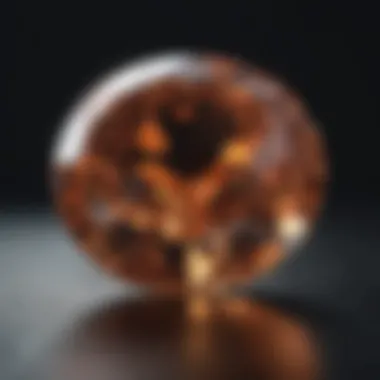
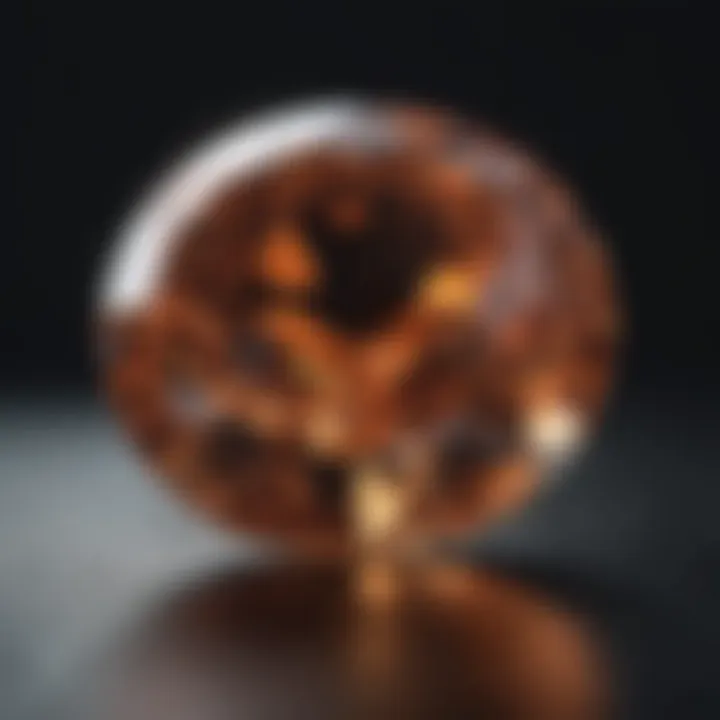
- Timelessness: Vintage styles often transcend fleeting trends, making them ideal for those who prefer classic pieces.
- Artistry: Many vintage diamonds showcase intricate craftsmanship that is often lost in modern mass production.
- Investment: Antique cuts can appreciate in value, particularly if they are of high quality, appealing to collectors and enthusiasts alike.
"Investing in a vintage diamond is not just about the stone; it's an investment in a piece of history."
Vintage diamonds often come with their own sets of challenges. Sourcing one that meets quality standards can be tricky, as some might have inclusions or chips from their history. However, the quest for these one-of-a-kind gems is part of the thrill for many buyers.
Rise of Ethical Diamonds
Equally compelling is the rise of ethical diamonds. Today's consumers are increasingly aware of the implications behind their purchases. They seek not only to adorn themselves with beautiful pieces but also to ensure that these gems are sourced responsibly and sustainably. Ethical diamonds, including lab-grown and responsibly mined options, cater to this conscientious buying behavior.
Several factors are driving this trend:
- Transparency: Shoppers want to know the story behind their diamonds. A transparent sourcing process adds to a diamond’s value in the eyes of ethical buyers.
- Environmental Concerns: The mining industry has faced criticism for its environmental impact. Lab-grown diamonds present a compelling alternative that minimizes ecological footprints.
- Social Responsibility: With the rise of blood diamonds—a term denoting gems sourced from conflict areas—many buyers are advocating for conflict-free certifications. This concern has led to an increased demand for diamonds that empower communities rather than exploit them.
As the market embraces this movement, it opens doors to innovative approaches in sourcing, creating a stylish yet socially responsible purchasing environment. Consumers today often share their buying experiences online, enhancing community engagement and awareness around these practices.
Investment Potential of Five Carat Diamonds
When considering an investment in gemstones, the five-carat diamond stands out as a notable contender. This large and significant size of diamond often captures the attention of collectors and savvy investors alike. The beauty, luster, and sheer size of such a diamond make it an alluring target in the world of luxury investments. More than just a pretty stone, it bears potential for financial return — if approached with some understanding of the market dynamics.
Investing in diamonds isn't just about owning a beautiful piece of jewelry. It's about recognizing the potential for appreciation in value over time. This particular size can create a perfect bracket for enthusiastic collectors and investors looking to diversify their portfolios. However, it's essential to grasp certain elements to maximize that potential.
The Case for Diamonds as Assets
Initially, one might think of stocks or real estate when diversifying investments, but diamonds can also be considered valuable assets. Just like any form of tangible asset, the market value of diamonds fluctuates based on several factors, including demand, rarity, and trends in consumer behavior. In this regard, five-carat diamonds often hold a significant advantage due to their size. Many buyers perceive them as symbols of status and success.
- Rarity and Demand: Larger diamonds are, generally speaking, rarer. A five-carat diamond’s rarity can contribute to its desirability and, subsequently, its price appreciation.
- Hedging Against Inflation: Just like gold, diamonds may serve as a hedge against inflation. As currency values fluctuate, luxury items tend to maintain or even grow in value.
- Cultural Significance: In various cultures, diamonds symbolize wealth and commitment. This cultural weight can enhance their desirability, ensuring that they remain valuable assets for generations to come.
Investors should know, however, that buying a diamond isn't as straightforward as it seems. Understanding the nuances behind valuation, like the Four Cs, is crucial. One needs to differentiate between price appreciation and sentimental value, the latter being more subjective.
Resale Value Considerations
The resale value of a five-carat diamond is another critical aspect to consider. It's one thing to invest, but another to realize those gains when one chooses to sell. Here are some crucial considerations that affect the resale market:
- Certification: A certified diamond can often command a higher resale price. Certificates from reputable gemological institutions affirm the quality and characteristics of a diamond, giving potential buyers confidence.
- Market Timing: Like any investment, timing plays a significant role. A well-informed seller will know when the demand peaks, allowing them to fetch a better price.
- Condition and Setting: The diamond’s condition can dictate its value upon resale. A diamond that has been well-maintained and is in an appealing setting will likely sell for more than one that’s been neglected.
- Trends in Consumer Preferences: Keep an eye on what styles or cuts are gaining traction. Sometimes, a certain cut or shape may drive the price, and knowing these trends can help in making informed investment decisions.
"Investing in diamonds requires patience, understanding, and a keen eye for market trends. It’s not just about the carat but the entire value chain that influences worth over time."
Final Considerations
When investing in a five-carat diamond, there are several critical factors that go beyond what we typically think about regarding the gem itself. Understanding these factors helps ensure that buyers make informed decisions, protecting their investment while enhancing their connection to the gemstone.
One key element is warranties and aftercare. Just like purchasing a new car comes with a warranty, so too should buying a high-value diamond ring. Warranties often cover potential defects and can provide peace of mind. Moreover, aftercare is essential in maintaining the diamond’s brilliance and integrity. Regular cleaning and proper storage can prolong a diamond’s life, preventing the accumulation of dirt and oils that can obscure its beauty. Aftercare also includes checking for loose settings regularly, which could lead to stones falling out.
Being vigilant about these aspects not only protects your investment but aids in preserving the personal value that a diamond carries. Warranties and aftercare are not just about physical upkeep, they represent a form of stewardship over your jewelry, honoring the craftsmanship that went into it.
Warranties and Aftercare
When the excitement of a new purchase diminishes, assessing any warranties attached to your five-carat diamond can be an eye-opener. Make sure to keep all documentation intact. A good warranty should cover issues like manufacturing defects. For example, if a diamond loses its shine due to a flawed cut, you could find comfort knowing you're entitled to either repairs or replacements.
However, warranties can vary in what they cover, so it’s worth reading the fine print. Ask questions when you're picking your diamond, like what exactly the warranty entails and how long it lasts. This can sometimes make the difference between dissatisfaction and satisfaction later on.
Aftercare should not be neglected. It includes steps like:
- Regular Cleanings: Use gentle methods and professional services to keep your diamond sparkling.
- Safe Storage: When not adorning your finger, store it in a soft cloth or a jewelry box to avoid scratches.
- Periodic Checks: Visiting a jeweler to ensure the stone is secure in its setting.
Taking these simple actions can ensure your five-carat diamond remains as dazzling as the day you bought it.
The Importance of Expert Guidance
With the global diamond market being a maze of choices, expert guidance is invaluable. It can save you time, money, and heartache as you navigate through various options. The complexity lies not just in understanding terms like the four Cs but also in grasping nuances like market pricing and the implications of certifications.
For buyers, the right expert can help identify the best quality diamonds within your budget. They will also present comparatives that can elevate your understanding of both value and aesthetics, making you more confident in your choices. With diamonds, there’s always a nuanced conversation around color and clarity.
Furthermore, a certified gemologist or a jeweler with a solid reputation can guide you regarding resale options. If your intentions include long-term investments, insights from professionals can prove to be the golden ticket to appreciating value over time.



